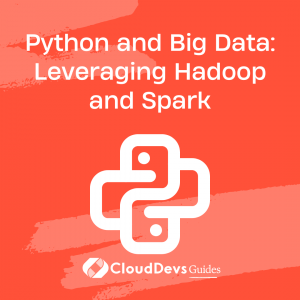Python and Big Data: Leveraging Hadoop and Spark
Table of Contents
Big Data has become an essential aspect of modern businesses, and Python is a popular programming language for data analysis. Hadoop and Spark are two widely used open-source Big Data frameworks that offer efficient storage, processing, and analysis of large datasets across clusters of computers. In this blog, we will explore how Python can be leveraged with Hadoop and Spark to process and analyze Big Data.
1. Overview of Hadoop and Spark
Hadoop is an open-source framework that enables distributed storage and processing of large datasets across clusters of computers. It consists of two primary components – Hadoop Distributed File System (HDFS) and MapReduce. HDFS is used to store large datasets across a cluster of machines, while MapReduce is a programming model used to process and analyze data in parallel across the cluster.
Spark is an open-source distributed computing system designed for processing and analyzing large-scale datasets. It can run on top of the Hadoop ecosystem and supports Hadoop YARN, Apache Mesos, or standalone. Spark provides an API for programming in Python, Java, Scala, and R, making it accessible for developers with different skill sets.
2. Leveraging Python with Hadoop
Python is an easy-to-use programming language for data analysis and has various libraries and frameworks like Pandas, NumPy, and SciPy, making it simple to process and analyze large datasets. Hadoop provides a Python library called Hadoop Streaming, which allows developers to write MapReduce programs in Python.
3. Python MapReduce Program in Hadoop
Here is an example of a Python MapReduce program that calculates the word count of a large text file:
import sys
for line in sys.stdin:
for word in line.strip().split():
print("%s\t%s" % (word, 1))
In this program, we read the input from standard input, split each line into words, and emit a key-value pair for each word. The key is the word itself, and the value is 1. The output is written to standard output, where Hadoop can process it.
4. Leveraging Python with Spark
PySpark is a Python interface to Spark’s core programming model and Resilient Distributed Datasets (RDD) API. RDDs are the fundamental data structure in Spark and represent an immutable distributed collection of objects that can be partitioned across a cluster and processed in parallel.
5. Python Spark Program
Here is an example of a PySpark program that calculates the word count of a large text file:
from pyspark import SparkContext
sc = SparkContext("local", "Word Count")
text_file = sc.textFile("hdfs://path/to/text/file")
words = text_file.flatMap(lambda line: line.split())
word_counts = words.map(lambda word: (word, 1)).reduceByKey(lambda a, b: a + b)
word_counts.saveAsTextFile("hdfs://path/to/output/dir")
In this program, we create a SparkContext object and specify the cluster’s URL and application name. We then read the input text file from HDFS using the textFile method and split each line into words using the flatMap transformation. We then use the map transformation to emit a key-value pair for each word, where the key is the word itself, and the value is 1. Finally, we use the reduceByKey transformation to group the key-value pairs by key and sum the values. The output is saved to an output directory in HDFS using the saveAsTextFile method.
6. Other Python Libraries for Big Data
Apart from Hadoop and Spark, there are other Python libraries like Dask and Apache Arrow that can be used to process and analyze Big Data. Dask provides a parallel computing framework for Python that can scale to clusters of computers. Dask provides a similar API to Pandas, making it easy for developers familiar with Pandas to use Dask.
Apache Arrow provides a cross-language development platform for in-memory data. Arrow provides a common format for representing data that can be shared across different programming languages and systems, making it easier to move data between different tools and technologies.
7. Conclusion
Python is a popular programming language for data analysis, and Hadoop and Spark are widely used open-source Big Data frameworks. By leveraging Python with Hadoop and Spark, developers can build scalable and efficient data processing and analysis pipelines. Additionally, there are other Python libraries like Dask and Apache Arrow that can be used to process and analyze Big Data. With these powerful tools and technologies, businesses can extract valuable insights from their data and make informed decisions.
To summarize, businesses that leverage Big Data to gain insights and make data-driven decisions can benefit significantly by using Python with Hadoop and Spark. Python offers a simple and intuitive programming interface for data analysis, while Hadoop and Spark provide scalable and efficient distributed computing platforms for Big Data processing and analysis. By using the right combination of tools and technologies, businesses can unlock valuable insights from their data and stay ahead of the competition.


